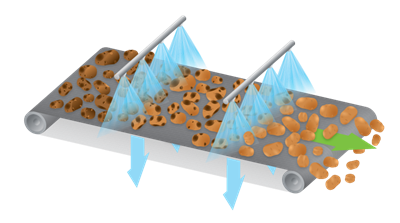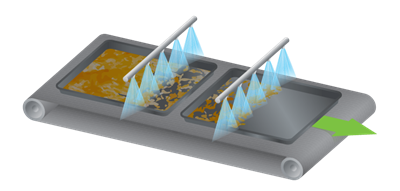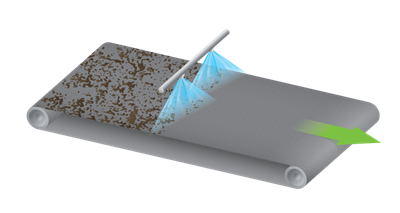Nozzles for cleaning applications
Outside of tanks and vessel cleaning (see tank cleaning section for details) many other parts of a food processing plant need cleaning. This is achieved by directional nozzle systems. Typically nozzles will be arranged on a spray bar and will direct a line of high-impact spray at the product or conveyor system below.
Spray requirements
Most cleaning applications require a reasonably high impact spray to remove residue. As such, flat fan nozzles are the most common choice. For some more delicate rinse applications a low flow rate and low impact full cone nozzle may also be suitable. For very tough and robust cleaning systems a directed flat fan nozzle like the SPN nozzle will be deployed to maximise the impact of the spray.
Spray bar arrangements
When cleaning a moving conveyor below (either the conveyor itself or product on the conveyor) multiple nozzles will need to be arranged on a spray bar. Normally these will be flat fan nozzles but for lighter rinses low flow rate cone nozzles may be deployed to reduce impact. With fan nozzles a line of spray is produced by the nozzle. The spray angle and distance from the target will determine how wide the spray is at the point of impact. This will then determine how many nozzles are required. It is advisable to overlap the spray patterns by 10% or more to compensate for the fact that the spray tends to taper at each end. This overlapping will result in a more even cleaning spray line. So the spray patterns do not interfere with each other it is advisable to angle the patterns by 5-10 degrees, as shown in the diagram.
The speed of the conveyor and the flow rate of the nozzle at a given pressure will dictate how much fluid is delivered per square metre of product. Exactly how much fluid is required will depend very much on the residue that needs to be cleaned, but typical rules of thumb will be:
 Tough residue: Over 5 l/m2
Tough residue: Over 5 l/m2
A 1 metre wide conveyor running at 0.5 m per second. Cleaning potatoes. Two spray bars with four nozzles on each are deployed. With a 10% overlap of patterns this means each nozzle needs to cover 275mm meaning if 40 degree nozzles are used the spray bar would need to be 377.8mm from the target.
Each nozzle delivers 20 litres per minute of spray meaning 160 litres per minute are delivered over the whole system. As the conveyor is moving at 0.5 m/second this means that the whole system will deliver 160/60 litres per second or 5.3 litres per m2 of conveyor.
 Medium residue: 2-5l/m2
Medium residue: 2-5l/m2
A 1.5 metre wide conveyor containing used baking tins containing residue needs to be cleaned. The conveyor is moving at 0.5m/second. Two spray bars with 5 nozzles on each are deployed. With a 10% overlap on sprays this means that each nozzle needs to cover 33 cm of the belt. If a 65 degree fan nozzle is deployed this means the spray bar needs to be 518mm above the target. T he 5 nozzles deliver 12.9 litres per minute each at 2 bar pressure. This means the whole system delivers 129 litres per minute or 2.15 l/ second. Every second 0.75 m2 of conveyor moves under the spray bars so 2.87 l/m2 of fluid is delivered.
 Light residue (example): 0.5-2 l/m2
Light residue (example): 0.5-2 l/m2
A 1 metre wide conveyor moving at 0.5 m/second needs to be rinsed of a light residue left from product further up the production line. If 2 x 90 degree spray angle nozzles are deployed and a 10% overlap of spray is delivered then the nozzles need to be 275mm from the target. If each nozzle delivers 10 l/minute at 1 bar pressure then the system delivers 20 l/minute or 0.33 l/ second. In one second 0.5 m2 of conveyor passes under the spray bar so 0.66l/ m2 is delivered.
Improving impact
The narrower the spray angle of the nozzle the higher the impact will be. This is not simply due to the fact that more spray is concentrated in a smaller area. Narrow angle nozzles deliver kinetic energy more efficiently as less is 'wasted' distributing the fluid. This means that two smaller narrow angle nozzles that deliver the same fluid over the same area as one larger wide angle nozzle will give more impact cleaning.
So to improve cleaning efficiency use more narrow angle nozzles rather than less wide angle nozzles.
Another way to improve impact is to swap to deflector style fan nozzles. These are more efficient and produce a harder driving spray resulting in more impact per litre of fluid delivered.
Nozzle selection
Please click on the boxes below for individual data sheets